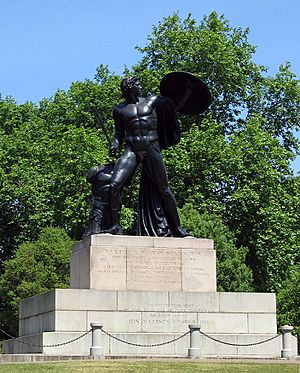Wellington Monument, London facts for kids
The Wellington Monument is a famous statue in London, found at the end of Park Lane. It honors Arthur Wellesley, who was the first Duke of Wellington. This monument celebrates his important victories in wars like the Peninsular War and the later parts of the Napoleonic Wars. It was officially opened on June 18, 1822. The monument, including its base and the small hill it sits on, stands about 36 feet tall.
Contents
What is the Wellington Monument?
The most well-known part of the Wellington Monument is a huge 18-foot-tall statue of Achilles. This impressive statue was created by the sculptor Richard Westmacott. What's really cool is that it was made from melted-down cannons captured from enemy armies!
The Story Behind the Achilles Statue
The statue of Achilles shows the Greek hero as a strong young man. He is holding up his shield with his left hand and a short sword in his right. His armor is next to him, and a cloak is draped over his left shoulder. The way Achilles is posed was inspired by ancient Greek and Roman statues, especially the "Borghese Gladiator" and the "Quirinal Horse Tamers."
How the Monument Was Funded
This monument was paid for by donations from British women, who raised a total of £10,000. When the giant statue was being moved to its spot, the entrance gates to Hyde Park were too low for it to pass through. So, workers had to make a hole in the nearby wall to get it to its final place!
What the Inscription Says
The base of the statue is made from Dartmoor granite and has a special message carved into it. It says:
- To Arthur Duke of Wellington
- and his brave companions in arms
- this statue of Achilles
- cast from cannon taken in the victories
- of Salamanca, Vittoria, Toulouse, and Waterloo
- is inscribed
- by their country women
- Placed on this spot
- on the XVIII day of June MDCCCXXII
- by command of
- His Majesty George IIII.
This inscription tells us that the statue was a gift from the women of Britain to the Duke of Wellington and his soldiers. It also lists some of the famous battles where cannons were captured to make the statue, like the Battle of Waterloo. It was placed there on June 18, 1822, by order of King George IV.


